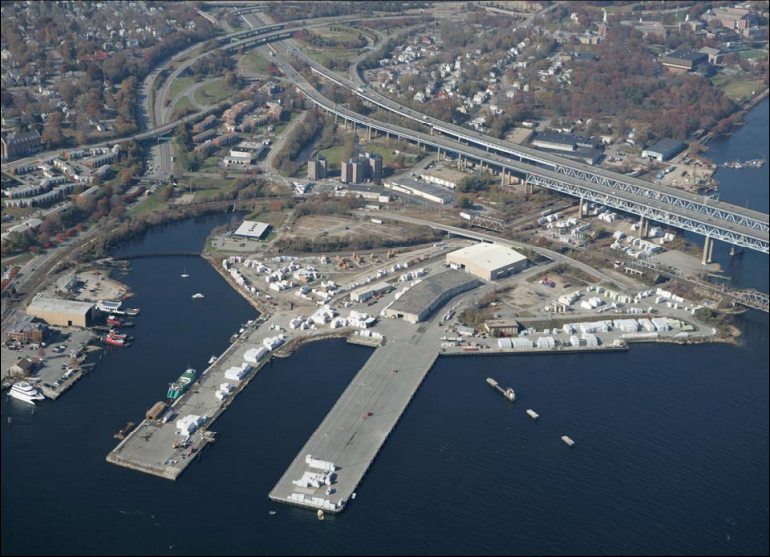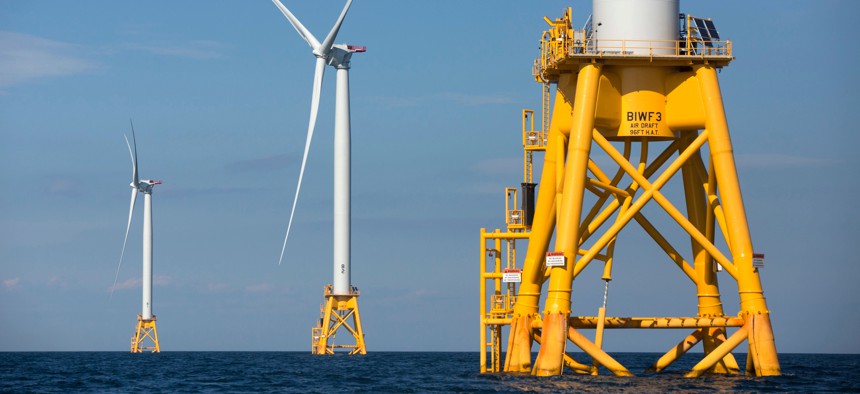Connecting state and local government leaders
Along the East Coast, states and companies are joining to make big investments in port upgrades, as the region eyes a decade of job growth tied to renewable energy.
The beginnings of an offshore wind industry are starting to take shape along the eastern seaboard from the state of Massachusetts to Delaware Bay. But to really take off, the industry will require modernized ports capable of handling the large towers and blades of the latest turbines, and the deepwater ships that will deploy them to sea.
Exactly the kind of investment that will be needed can be seen in Connecticut, where the state announced in early May a $93 million dollar partnership to upgrade the State Pier in New London. The property has key attributes important for development of offshore wind: a flat expanse of real estate to lay down parts and inventory, sufficient depth at portside to receive jack-up ships, and an unobstructed gateway to Long Island Sound free of overhead bridges. And one bonus feature: a working rail line that crosses the property, a potential aid in future freight delivery.
Given the pipeline of future wind power that seven states have now committed to building, however, the East Coast will need several such ports, if not more, to service a decade long buildout of wind power infrastructure. Moreover, the pace of wind power technology advancement is moving so quickly that this first round of upgrades is unlikely to be the last. The size of a single offshore wind turbine has grown from a 6 MW (megawatt) unit just several years ago, standing about 400 feet high, to a 12 MW unit today, over 800 feet high. And the industry thinks it may be headed to a 15 MW unit, with a possible topping out at 20 MW for a single turbine. A recent Bloomberg survey of European shipbuilders illustrated the challenge. It can take years to plan and construct a new generation of ships, but how to design for such rapidly changing technology? American ports, entering an upgrade cycle today, will eventually face the same question.
“We will want to get started now, using current European methods,” says Willett Kempton, a professor at the University of Delaware’s School of Marine Science and Policy. However, he explains, to get the deployment rate up in the years ahead, the industry will have to incorporate the latest approaches. Kempton is co-author of an intriguing paper, Industrializing Offshore Wind, that quantifies how the industry, in its next phase, could harvest significant cost reductions by moving turbine assembly to onshore ports. Up until now, only assembly of the tower has taken place on land, with the nacelle (the box that holds the turbine) and the blades hoisted into position out at sea. But Kempton proposes that swinging assembly back on land could cut costs and time, in part, because offshore assembly is far less efficient. Moreover, there may be hidden value to exploit in the ports themselves, as they represent a lower cost node of the supply chain. “The economics of this are interesting,” says Kempton. “For example, the cost of an upgraded port is roughly $200 million, plus or minus 40%. And that may strike some people as a large expense. But the cost of an installation vessel is $500 to $600 million. And the cost of a 1 GW offshore wind farm is $3 billion. So, we don't need to worry or focus on the port cost—it's the cheapest part of this equation.”
*****
The timing of port upgrades can be tricky. The state of Massachusetts, for example, acted first as a pioneer but wound up a patient investor when, having spent $113 million to upgrade the port of New Bedford in 2013, officials watched their first deal fall apart at the cancellation of the Cape Wind project in 2015. Those structural investments were substantial, and included a geotechnically engineered table-top that can withstand loads of 4,100 pounds per square foot, and extensive dredging in the harbor. (The dredging operation itself was problematic as the contractor ran into unexpected rock removal, in addition to mud). But today the New Bedford Marine Commerce Terminal is finally generating a return. Vineyard Wind will build an 800 MW offshore farm 14 miles off the coast, paying $9 million for the lease over 18 months.
“New Bedford is one of those cases where it did seem to be before its time, but now, is turning out to be just in time,” says Stephanie McClellan, director of the University of Delaware’s Special Initiative on Offshore Wind (SIOW).
The picture is changing rapidly.
According to a March 2019 forecast authored by McClellan and SIOW, seven states from Massachusetts to Virginia have committed to create an 18.6 gigawatt (GW) pipeline of offshore wind to be constructed by the year 2030. This represents a $68 billion capital investment. In early June, SIOW raised the forecast again, to 20 GW. Although the states are making their plans individually, they stand to benefit collectively from lower costs as the scale of the pipeline grows. Accordingly, many of these states, like Connecticut, which has 2.3 GW in the pipeline, are now moving quickly to invest in port infrastructure. In February, New York announced $200 million for port upgrades.
“Different states have a different tolerance for risk.” explains McClellan. “Massachusetts was a first mover in such a variety of ways. They were willing to invest, and to spend political capital. And that really benefited the whole push to get offshore wind going.”
Now that offshore wind is getting closer to actual construction, explains McClellan, the financing structure for ports is changing. “Massachusetts took a very go-it-alone approach. But now what we’re starting to see is industry doing their fair share. That's either through cooperative agreements and economic development deals, or, a regulatory process that makes that a requirement.” To McClellan’s point, the $93 million dollar upgrade to the State Pier in New London is a three way deal between the Connecticut Port Authority, Eversource (the state’s largest utility) and the Danish wind giant Ørsted. In October of last year, Ørsted took its first toehold in the North American market by purchasing the Providence, Rhode Island-based Deepwater Wind.
So far, the eastern seaboard has just a single offshore wind farm call Block Island Wind (which Ørsted picked up in its October purchase). It is really quite tiny: just five turbines installed, each a 6 megawatt unit, for a total of 30 MW. This small array was mounted using several existing small ports around Narragansett Bay, from Quonset Point to Providence. One possibility is that a future East Coast wind industry will establish a kind of network of differing port sizes, all working together in concert. McClellan points out, for example, that Long Island is slated to host an operations and maintenance center for Ørsted—not a place where turbines are assembled or deployed, but where equipment and other parts and labor could be organized. In another example of this port type, the recent deconstruction of a large coal plant at Brayton Point near Fall River, Massachusetts has been identified by its property owner, CDC of St Louis, as yet another supporting piece of real estate to the industry. Generally speaking, however, a limitation for any candidate port from Fall River to Providence is that Narragansett Bay is corralled by bridges. The Clayborne Pell Newport bridge may seem high, its roadway more than 200 feet above the water, but that’s not high enough. To deploy the kinds of large farms that are coming, like the 800 MW Vineyard Wind project—twenty-five times the size of tiny Block Island Wind in capacity, and which will surely utilize much larger turbines—nothing less than obstruction-free waterways will suffice.
*****
A jack-up vessel when traveling bears large tower-like tubes, known as spuds, that rise high above the deck, which are then lowered out at sea to create a stable platform for wind turbine installation. In 2014 the U.S. Department of Energy commissioned a study to look at the country’s port readiness for an offshore wind industry and one of the issues highlighted in the report was the ability of candidate ports to berth, at quayside, the large jack-up vessels the industry currently uses. That’s why the New Bedford project was in part a dredging operation, to handle deep vessel drafts.
“The industry is very interested in New London,” says Evan Matthews, executive director of the Connecticut Port Authority. The draft at State Pier’s portside is 36 feet, and the main channel is 40 feet deep, he says. One reason New London is already up to requirements is that it’s long been a major maritime center, host to the Naval Submarine base, ferry routes, and General Dynamic’s Electric Boat. “The Port Authority really got into action in 2016, with a goal to revive our maritime economy. With the Ørsted/Eversource deal, we’re are looking at going from State Pier activity at just one ship per month to 1-2 ships per week,” says Matthews. “And it’s not just New London, we’re looking to invest in New Haven and Bridgeport as well.” Like New London, both New Haven and Bridgeport have extensive real estate that sits south of Interstate 95, providing critical, bridge-free clearances. Matthews is also careful to point out that, despite the terms of the deal—which also provides an annual fixed fee of $3 million to the Port Authority—Connecticut’s goal is to simply work in league with all the other states pursuing the same goal. “We didn’t offer any incentives, and we are not out here saying ‘we won.’ The industry provides the income we need to invest, and we are here to be a part of the larger picture.”

European ports like Hull in the United Kingdom, at 133 acres, and Esbjerg in Denmark, at 250 acres, are massive. And one issue that may come up, according to Delaware’s Kempton, is that many candidate ports in this country are much smaller. New Bedford is 28 acres. New London, according to Matthews, is currently around 22 acres but will be 30 acres as a finished facility. To really make a dent, however, in the East Coast’s electricity demand will require a more rapid deployment rate, explains Kempton, and that will require either bigger ports, or, perhaps a larger network of smaller ports. “I want to make sure we can do this at the rate of 3GW a year, not 800 MW every three years. Why does that matter? Because you have to do at least 1 to 2 GW per year just to cover retirements of the fossil fuel plants," he said. Thirty-acre ports, explains Kempton, may be adequate staging grounds for deployment, but would not have enough room to also host manufacturing at the same time. That said, the European industry, although it has very large ports at its disposal, already uses supply chain networks where blades and parts, for example, are ferried long distances from other locations.
Looking ahead, a burgeoning offshore wind industry in the U.S. will also need skilled personnel. “Offshore wind is a very specialized industry,” says SIOW’s McClellan, “and we really don’t have quite enough people yet here in the U.S., with experience.” McClellan and the University of Delaware are meeting that challenge right now, she says, by establishing The Offshore Wind Skills Academy, a joint venture with the Danish Energy and Climate Academy. The first session took place in March, and the next is coming up in June. “There are so many professional needs in this industry from financial, to legal, to public affairs skills," she said. "The academy’s aim is to get started now, building the professional capacity we will soon need.”
Gregor Macdonald is a journalist who regularly covers cities, climate and energy. He is based in Portland, Oregon.

NEXT STORY: How Should We Define the Suburbs?



